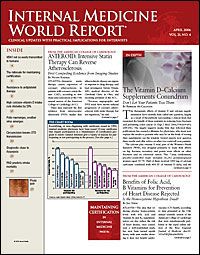Publication
Article
Internal Medicine World Report
Treatment of Prehypertension May Halt Progression to True Hypertension
Author(s):
ATLANTA—New data presented at the 55th scientific session of the American College of Cardiology suggest that pharmacologic treatment of prehypertension may delay or halt the development of true hypertension.
An estimated 70 million Americans have prehypertension, defined as a blood pressure (BP) of 120 to 139 mm Hg systolic or 80 to 89 mm Hg diastolic. Prehyper?ten?sion has been established as a precursor of hypertension and is associated with significant increases in cardiovascular disease–related mortality and complications.
These new results, from the Trial of Preventing Hypertension (TROPHY), were reported by Stevo Julius, MD, active emeritus professor of cardiovascular medicine at the University of Michigan Cardiovascular Center, Ann Arbor, Mich.
“If our data are backed up by additional research, it may be possible to reduce the increased risk of the heart disease and stroke that affect the 65 million Americans who have progressed to true hypertension,” he said.
“If our data are backed up by additional research, it may be possible to reduce the increased risk
of the heart disease and stroke that affect the 65 million Americans who have progressed to true hypertension.”
— Stevo Julius , MD
In this study, 809 patients with prehypertension were randomized to 2 years’ therapy with the angiotensin receptor blocker (ARB) candesartan (Atacand) or placebo, followed by 2 years of placebo for all participants. Patients’ BP levels ranged from 130 to 139 mm Hg systolic, 85 to 89 mm Hg diastolic, or both, meaning that the patients were in the upper half of the prehypertensive spectrum.
Antihypertensive drug treatment was started when the patients reached the study end point of stage 1 hypertension.
All patients also received counseling about diet and exercise for the control of BP and had routine BP assessments at home and at clinic visits.
After 2 years, 154 (40%) of the 381 placebo-treated patients had developed hypertension compared with only 53 (13.6%) of the 391 patients treated with the ARB.
At the end of the initial 2 years, both groups continued with placebo treatment for an additional 2 years (with no ARB therapy in either group). At the end of that additional 2 years, 240 (63%) of the original placebo group had hypertension, while the number of those who had taken candesartan for 2 years who progressed to true hypertension jumped to 208 (53%).
Key points
About 70 million Americans have prehypertension.
This study shows that early use of ARB therapy can significantly reduce the progression to true hypertension.
If confirmed by more studies, this could have significant implications for the control of hypertension and the reduction of cardiovascular events.
Pending future research, a healthy lifestyle focused on proper dietary measures and exercise remains the foundation of treatment for prehypertension.
Dr Julius pointed out that about 25 million Americans have approximately the same BP level as the study participants. He said that about two thirds of them will progress to stage 1 hypertension over the next 4 years. “The public health implications of our findings are potentially huge.”
Nevertheless, he cautioned against an overzealous interpretation of the results. First, the absolute decrease of 9.8% in hypertension after 4 years was modest. However, the last 2 years of that period did not include drug therapy, which may explain the low decrease after 4 years, compared with the impressive results after the initial 2 years of ARB therapy. And second, the trial was actually a proof-of-concept study, and thus more research is needed to determine whether early drug treatment in patients with ?prehypertension will improve clinical outcomes.
“What’s clear is that prehypertension rates are on the rise, and close attention to lifestyle measures, such as diet and exercise, have not had a sufficient impact on public health,” he observed. “Thus, we need to identify better strategies for individuals who are prehypertensive.”
The study was also published in the online rapid edition of the New England Journal of Medicine (doi:10. 1056/NEJ Moa 060838) with anaccompanying editorial (doi:10.1056/ NEJMe0680 57).





